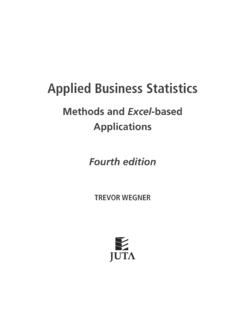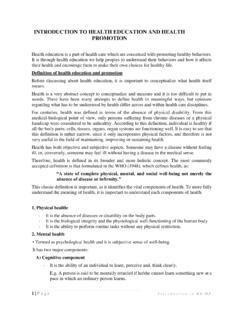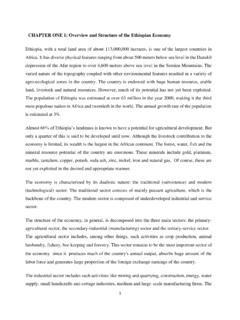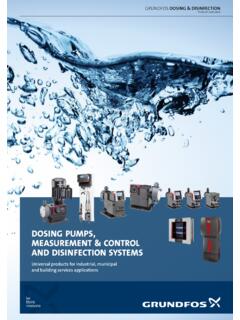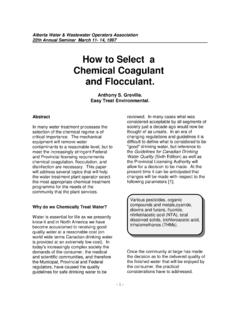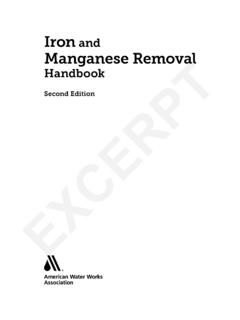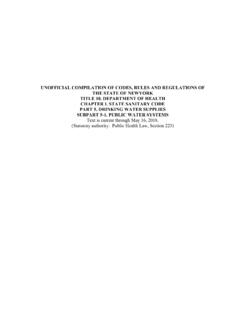Transcription of Principles of Water and Wastewater Treatment Processes
1 Principles of Waterand WastewaterTreatmentProcessesSeries EditorTom StephensonVolume EditorRichard StuetzPublished byIWA PublishingAlliance House12 Caxton StreetLondon SW1H 0QS, UKTelephone: 44 (0)20 7654 5500 Fax: 44 (0)20 654 5555 Email: published 2009#2009 Cranfield UniversityPrinted by Page Bros Ltd, Norwich, Norfolk, design by: OKS Prepress Services, from any fair dealing for the purposes of research or private study, or criticism or review, aspermitted under the UK Copyright, Designs and Patents Act (1998), no part of this publication maybe reproduced, stored or transmitted in any form or by any means, without the prior permission inwriting of the publisher, or, in the case of photographic reproduction, in accordance with the termsof licences issued by the Copyright Licensing Agency in the UK, or in accordance with the terms oflicenses issued by the appropriate reproduction rights organization outside the UK. Enquiriesconcerning reproduction outside the terms stated here should be sent to IWA Publishing at theaddress printed publisher makes no representation, express or implied, with regard to the accuracy of theinformation contained in this book and cannot accept any legal responsibility or liability for errorsor omissions that may be information provided and the opinions given in this publication are not necessarily those ofIWA and should not be acted upon without independent consideration and professional and the Author(s) will not accept responsibility for any loss or damage suffered by any personacting or refraining from acting upon any material contained in this Library Cataloguing in Publication DataA CIP catalogue record for this book is available from the British LibraryLibrary of Congress Cataloging- in-Publication DataA catalog record for this book is available from the Library of CongressISBN: 1843390264 ISBN13.
2 9781843390268 ContentsIntroduction to theWater and WastewaterTreatment TechnologiesSeriesvWater Science at Cranfield UniversityviEditorsviiHow to Use This BookviiiIntroduction to Principles of Water and WastewaterTreatment ProcessesixUnit 1 Water of Quality Water Quality Assessment to Exercises21 Unit 2 Assessment Question44 Unit 3 Physical Assessment to Exercises71 Unit 4 Chemical Solution and and and Corrosion Inhibition96 ContentsPrinciples of Water and Wastewater Treatment Assessment Solutions to Exercises99 Unit 5 Sorption Exchange Exchange Bed Exchange in Wastewater Assessment to Exercises115 Unit 6 Biological Fixed Film Suspended Growth Assessment of to Exercises145 Unit 7 Membrane and Membrane Process Process Assessment Solutions to Exercises163 Unit 8 Sludge Treatment and Sources and Assessment to Exercises185 Unit 9 Odour Assessment to Exercises202 Solutions to Self Assessment Questions205 ContentsivPrinciples of Water and Wastewater Treatment ProcessesIntroduction to theWater and Wastewater Treatment TechnologiesSeriesThis series of texts, termedmodules, is designed to provide an education inwater and Wastewater Treatment from a process engineering perspective.
3 Atthe end, you should have a thorough understanding of the design, operationand management of Water and Wastewater Treatment Processes . This mightbe the Treatment of an industrial effluent to a standard acceptable for disposalto sewer, or Treatment of municipal sewage to meet an environmentaldischarge consent, or the production of Water suitable for drinking abstractedfrom a river. In almost all cases, a single process , usually termed aunitoperation, will not be able to achieve the required level of is achieved through linking the right unit operations in designing, operating or managing a process to provide a certain qualitywater, it is better to first consider the individual unit operations that whenlinked together form the required process flowsheet for the application. This isa chemical engineering approach, as it is about the conception, developmentand exploitation of Processes and their products. The process could be wateror effluent Treatment ; the product a less polluted aqueous engineers use physical, chemical and biological sciences andmathematics to provide a systems approach to the understanding of changeswhich take place in Processes , from the molecular to global scale, and toestablish methods which can be employed to achieve required changes incomposition, energy content, structure or physical state.
4 In other words,chemical engineering uses a science up approach to solving series of modules teaches the removal of pollutants from Water based onjust such a science up , chemical engineering approach. To understand aunit operation, the fundamental biology, chemistry or physics underlying thatunit operation needs to be properly understood. Nearly all unit operations areapplicable to different levels of Water and Wastewater Treatment , membrane Processes can be used in flowsheets for treatingmunicipal and industrial effluents, as well as potable supply and pure fundamental concepts of transmembrane pressure, flux rates, foulingetc., remain the same, whatever the application. Therefore the texts in thisseries are organised on just such a science up first module,Process Science and Engineering, covers the chemistry,biology and chemical engineering required for a proper understanding of theunit operations covered in the main technical modules. The second module, Principles of Water and Wastewater Treatment Processes , introduces theseunit operations, describing their overall form and operations are linkedtogether in a flowsheet to providewater and Wastewater Water andwastewater Treatment through achemical engineering MODULES Process Science andEngineering Principles of Water andWastewater TreatmentProcesses Risk Management for Waterand Wastewater UtilitiesModule IntroductionIntroductionPrinciples of Water and Wastewater Treatment ProcessesvWater Science at Cranfield UniversityA wholly postgraduate university, Cranfield is one of Europe s leadinginstitutions, world-renowned for its teaching and research.
5 Our postgraduatestudy programme is focused on real life rather than purely on theory. Wefacilitate work with industry and commerce, rather than just within theclassroom. As a result of this unique approach, our graduates are foundworldwide, making significant contributions in their Science within the School of Applied Sciences is an internationally-recognised centre of excellence undertaking research, training and con-sultancy in the science, engineering and management of Water . Activitiesencompass Treatment technologies, engineering, irrigation, socio-economics,management and policy as they relate to the improvement of Water qualityand the protection of natural, human and industrial University has a substantive portfolio and undertakes work indeveloped and developing countries for industrial, government and non-governmental view our web pages for more details or contact us via IntroductionIntroductionviPrinciples of Water and Wastewater Treatment ProcessesEditorsVolume EditorProfessor Richard Stuetzis Director of the University of New South Wales(UNSW) Water Research Centre (WRC), Sydney, Australia.
6 He waspreviously a Senior Lecturer at Cranfield University. He has a BSc and aPhD in Environmental Biotechnology from Stuetz is a member of the International Water Association and theAustralian Water Association. He teaches Water and Wastewater treatmentand environmental based courses to undergraduate and postgraduatestudents in Civil and Environmental Engineering at UNSW. His main areasof research interest are on-line instrumentation and control, fate of chemicalpollutants in the environment and biological Treatment Processes , and thetreatment and measurement of odours and volatile EditorProfessor Tom Stephensonis Professor of Water Sciences and Head ofSchool of Applied Sciences at Cranfield University. He graduated with a BScin Biochemistry from the University of York, UK, and has a PhD in CivilEngineering from Imperial College, University of London. He joined Cranfieldin 1990 and became Professor of Water Sciences in 1994. ProfessorStephenson is a Chartered Engineer and a Fellow of the Institution ofChemical Engineers and the Chartered Institution of Water and Environ-mental Stephenson has developed both full-time and part-time Mastersprogrammes in Water and Wastewater process technologies at Cranfield.
7 Hisresearch interests are centred on biological Wastewater Series Editor and Volume Editor acknowledge the technical writingcontributions of Mr Richard Hill, Visiting Fellow in Water Science and supportof Water Science colleagues, Professors Judd and Parsons and Drs Cartmelland IntroductionIntroductionPrinciples of Water and Wastewater Treatment ProcessesviiHow to Use This BookThis text, or module, has been designed forindividual self-paced can learn in your own time without requiring additional face-to-face section of the main text gives step-by-step learning in a particularsubject. These sections are and objectivesfor each Unitare given at the start. Following these, essential prerequisites are highlighted, which other Units contain concepts that you should understand beforestarting on the particular the start of each Section, in the right hand margin you will find an hourglasssymbol with an approximation of how long you will need to spend on thatSection. This is only an approximation, as this will be dependent on your priorknowledge and how easily you understand the main text of each Section is enhanced with figures and tables to aidunderstanding.
8 As you work through each section you will find, in the righthand margin,key pointshighlighted in the right hand margin there are alsoexercisesto help understand thematerial in the main text. You should attempt all exercises as you go throughthe text and then check your answers. These are provided at the end of the end of the main text for each unit there areself-assessment questionsthat you should attempt to test your understanding. The answers, withworking, are given at the end of the text. It is important that you do attempt theself-assessment questionsbeforeyou look at the answers. This will help yourunderstanding of the POINTSAs you work through eachsection you will find, in themargins, key points highlightedin a section requiresa study time of about1 hourEx the margin there are alsoexercises to help you understandthe material in the main IntroductionIntroductionviiiPrinciples of Water and Wastewater Treatment ProcessesIntroduction to Principles of Water and Wastewater TreatmentProcessesThe operation of unit Processes in Water and Wastewater Treatment dependson the fundamental sciences of chemistry, physics, biology and can use the printed material to learn about the key unit operations thatunderpin the Treatment of Water and Wastewater in your own text is divided into the following Units.
9 1 Water Quality2 Process Flowsheeting3 Physical Processes4 Chemical Processes5 Sorption Processes6 Biological Processes7 Membrane Processes8 Sludge Treatment and Utilisation9 Odour ManagementPrinciples of Water and Wastewater Treatment Processesmodule outlinesthe principle unit operations that are involved in the separation, degradationand utilisation of organic and inorganic matter during Water and module builds on the subjects of chemistry, biology and engineeringcovered inProcess Science and Engineering for Water and WastewaterTreatmentand provides a descriptive introduction to unit operations that arefurther described with numerical examples in later every attempt has been made to ensure that all the information iscorrect, it is almost inevitable that there will be errors in a document of thissize. If you do find any, please let us IntroductionIntroductionPrinciples of Water and Wastewater Treatment QualityContentsAims & Objectives2 Essential Compliance Treatment Plant Performance Process Measurement of Quality Measured Accuracy and Economics of Parameter Physical Organoleptic Chemical Biological Key Water Quality Physical Organoleptic Chemical Parameters (Inorganic) Chemical Parameters (Organic) Biological Self Assessment Solutions to Exercises21 Bibliography22 Unit 1 Water QualityPrinciples of Water and Wastewater Treatment Processes1 Aims and ObjectivesThis Unit covers the Principles of Water quality from Water and wastewatertreatment works:After studying these notes you should be able to:1.
10 Explain in your own words the following terms and concepts:compliance monitoringperformance monitoringprocess control2. describe the different quality parameters used to monitor Water qualityfrom Water and Wastewater Treatment is important that you are able to complete all the self assessment questionsat the end of this PrerequisitesIt is not necessary to have a completed any other Units before undertakingthis , information on the fundamentals for this Unit, refer to the followingUnits inProcess Science and Engineering for Water and WastewaterTreatment:Unit 1 Fundamentals of Water ChemistryUnit 4 Fundamentals of MicrobiologyUnit 7 Fundamentals of Process EngineeringUnit 1 Water Quality2 Principles of Water and Wastewater Treatment IntroductionWater and Wastewater Treatment plants are designed to provide Water andwastewater to an acceptable quality, however changes to the quality andquantity of raw Water and Wastewater as it arrives at a Treatment works as wellas operational conditions, can cause changes to the quality of the Water andwastewater as it is discharged from a Treatment plant.



